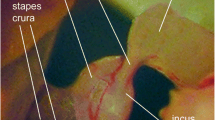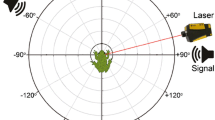Summary
-
1.
The expected resonance frequencies of the tympanal membrane have been calculated from its dimensions, mass, and compliance. The thin part of the tympanal membrane may vibrate independently of the entire tympanum. Thus, there are at least two sets of resonances (Fig. 8).
-
2.
The two sets of vibrations have been observed by means of laser holography (Figs. 13–15) and measured with a capacitance electrode (Figs. 16–18). The position and amplitude of the vibration patterns, the phase relationships, and the niteraction of the two sets of vibration have been studied. The results are compared with the frequency sensitivity of the four groups of receptor cells.
-
3.
The groups of receptor cells are attached to four specialized areas on the tympanum (Fig. 6). The vibrations of these areas of attachment are a maximum at the frequencies of maximum sensitivity in the receptor cells (Figs. 16 and 17). Thus, the frequency discrimination seems to be a purely physical phenomenon, based partly on the presence of the tympanal resonances, and partly on the different positions of the receptor cells on the tympanal membrane.
-
4.
The two sets of vibrations have different spatial positions on the tympanum. The centre of the entire-membrane-vibrations is situated in one end of the membrane (Fig. 15), whereas that of the thin-membrane-vibrations is almost at the centre of the tympanum (Fig. 14). The positions of the centers of vibration are, however, not constant (Figs. 13 and 14). Different modes may have somewhat different centre positions, and these positions may change with frequency because of interactions between the two sets of resonances. Therefore, receptor cells attached to different areas on the membrane may pick up different modes of vibration. Also, the receptor cells may almost fail to respond to some modes, if their area of attachment is at a nodal circle of these modes at resonance.
Similar content being viewed by others
References
Abramson, N., Andersson, H., Bjelkhagen, H.: Hologram avslöjar farlige flygplansfel. Ny Teknik (Stockh.) 1970,11, 3–5.
Autrum, H.: Anatomy and physiology of sound receptors in invertebrates. In: Acoustic behaviour of animals (R.-G. Busnel, ed.), p. 412–433. Amsterdam: Elsevier 1963.
Békésy, G. von: Experiments in hearing. New York: McGraw-Hill 1960.
—: Resonances in the cochlea? Sound3 (4), 86–91 (1969).
—: Travelling waves as frequency analysers in the cochlea. Nature (Lond.)225, 1207–1209 (1970).
Beranek, Leo L.: Acoustics. New York: McGraw-Hill 1954.
Crandall, Irving B.: Theory of vibrating systems and sound. London: MacMillan 1927.
Deutsch, S.: Models of the nervous system. New York: Wiley 1967.
Dumortier, B.: The physical characteristics of sound emission in Arthropoda. In: Acoustic behaviour of animals (R.-G. Busnel, ed.), p. 346–373. Amsterdam: Elsevier 1963.
Evans, E. F.: Narrow “tuning” of cochlear nerve fibre responses in the guinea-pig. J. Physiol. (Lond.)206, 14–15 P (1970).
Gabor, D., Stroke, G. W.: Holography and its applications. Endeavour28, 40–47 (1969).
Gray, E. G.: The fine structure of the insect ear. Phil. Trans. B243, 75–94 (1960).
Helmholtz, H. von: Die Lehre von den Tonempfindungen als physiologische Grundlage für die Theorie der Musik. Braunschweig: Vieweg 1862.
Herzog, R. O.: Fortschritte in der Erkenntnis der Faserstoffe. Z. angew. Chem.39, 297–302 (1926).
Huxley, A. F.: Is resonance possible in the cochlea after all ? Nature (Lond.)221, 935–940 (1969).
Jensen, M., Weis-Fogh, T.: Biology and physics of locust flight. V. Strength and elasticity of locust cuticle. Phil. Trans. B245, 137–169 (1962).
Johnstone, B. M., Boyle, A. J. F.: Basilar membrane vibration examined with the Mössbauer technique. Science158, 389–390 (1967).
Lax, Melvin: The effect of radiation on the vibrations of a circular diaphragm. J. acoust. Soc. Amer.16, 5–13 (1944).
Michelsen, Axel: Pitch discrimination in the locust ear: observations on single sense cells. J. Insect Physiol.12, 1119–1131 (1966).
—: The physiology of the locust ear. I. Frequency sensitivity of single cells in the isolated ear. Z. vergl. Physiol.71, 49–62 (1971).
Möller, Aage R.: Studies of the damped oscillatory response of the auditory frequency analyzer. Acta physiol. scand.78, 299–314 (1970).
Morse, Philip M.: Vibration and sound, 2. ed. New York: McGraw-Hill 1948.
Nakajima, S., Onodera, K.: Membrane properties of the stretch receptor neurones of crayfish with particular reference to mechanisms of sensory adaptation. J. Physiol. (Lond.)200, 161–185 (1969).
— —: Adaptation of the generator potential in the crayfish stretch receptors under constant length and constant tension. J. Physiol. (Lond.)200, 187–204 (1969).
Pennington, K. S.: Advances in holography. Scient. Amer.218, 40–48 (Febr. 1968).
Powell, R. L., Stetson, K. A.: Interferometric vibration analysis by wavefront reconstruction. J. opt. Soc. Amer.55, 1593–1598 (1965).
Pumphrey, R. J.: Hearing in insects. Biol. Rev.15, 107–132 (1940).
Rayleigh, Lord: Theory of sound. London: MacMillan 1926.
Schwabe, J.: Beiträge zur Morphologie und Histologie der tympanalen Sinnesapparate der Orthopteren. Zoologica20, 1–154 (1906).
Skudrzyk, E.: Die Grundlagen der Akustik. Wien: Springer 1954.
Stetson, K. A.: Vibration measurement by holography. In: Symposion on the engineering uses of holography (E. R. Robertson, ed.), p. 307–331. Cambridge: University Press 1970.
Tonndorf, J., Khanna, S. M.: Displacement pattern of the basilar membrane: a comparison of experimental data. Science160, 1139–1140 (1968).
Whitfield, I. C.: Coding in the auditory nervous system. Nature (Lond.)213, 756–760 (1967).
Wiener, F. M.: On the relation between the sound fields radiated and diffracted by plane obstacles. J. acoust. Soc. Amer.23, 697–700 (1951).
Author information
Authors and Affiliations
Rights and permissions
About this article
Cite this article
Michelsen, A. The physiology of the locust ear. Z. Vergl. Physiol. 71, 63–101 (1971). https://doi.org/10.1007/BF01245155
Received:
Published:
Issue Date:
DOI: https://doi.org/10.1007/BF01245155




